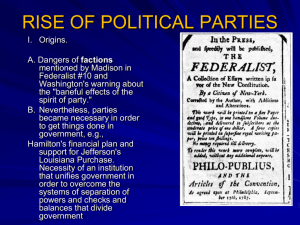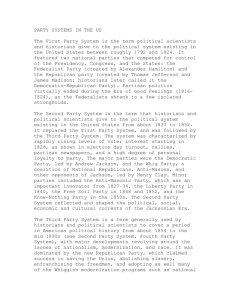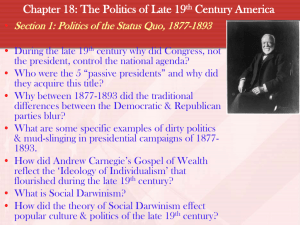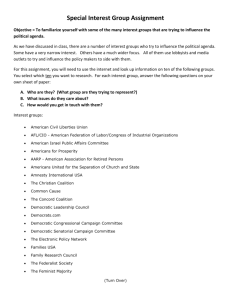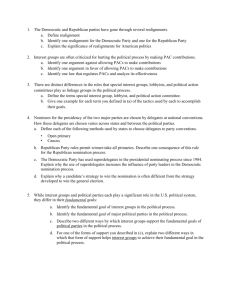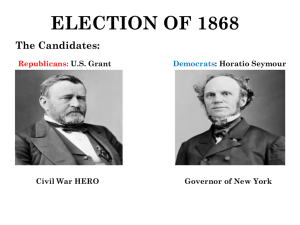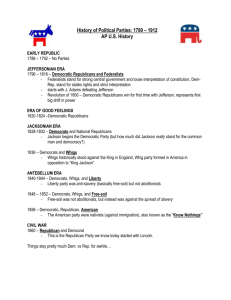Political parties in the United States, 1896–1929
advertisement
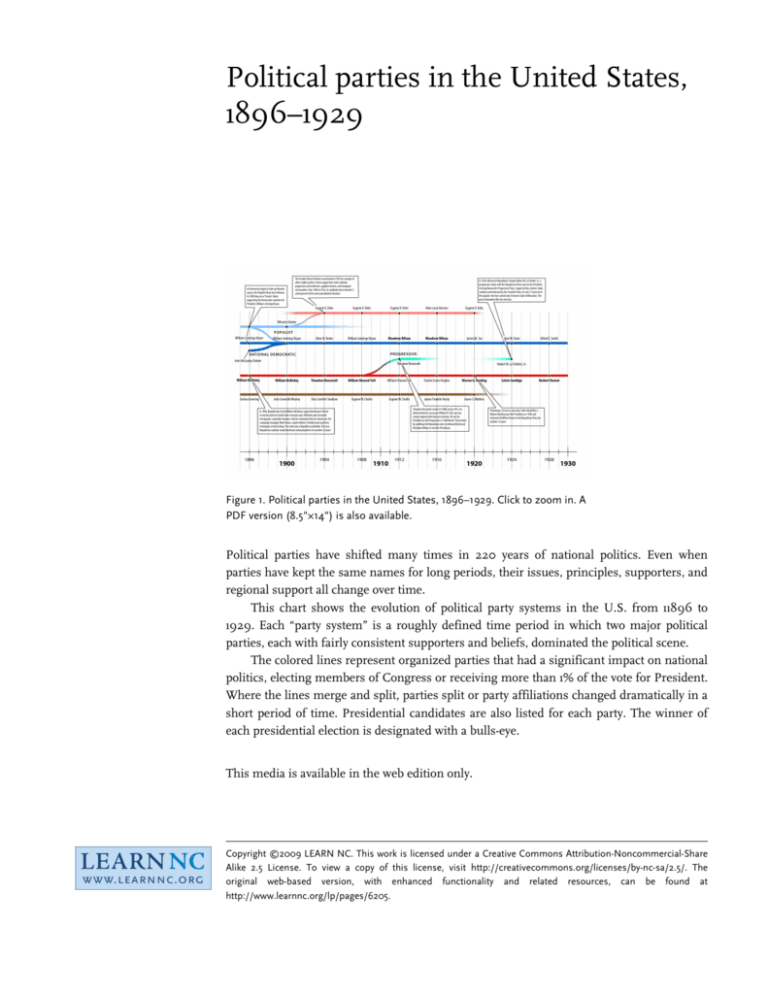
Political parties in the United States, 1896–1929 Figure 1. Political parties in the United States, 1896–1929. Click to zoom in. A PDF version (8.5"×14") is also available. Political parties have shifted many times in 220 years of national politics. Even when parties have kept the same names for long periods, their issues, principles, supporters, and regional support all change over time. This chart shows the evolution of political party systems in the U.S. from 11896 to 1929. Each “party system” is a roughly defined time period in which two major political parties, each with fairly consistent supporters and beliefs, dominated the political scene. The colored lines represent organized parties that had a significant impact on national politics, electing members of Congress or receiving more than 1% of the vote for President. Where the lines merge and split, parties split or party affiliations changed dramatically in a short period of time. Presidential candidates are also listed for each party. The winner of each presidential election is designated with a bulls-eye. This media is available in the web edition only. Copyright ©2009 LEARN NC. This work is licensed under a Creative Commons Attribution-Noncommercial-Share Alike 2.5 License. To view a copy of this license, visit http://creativecommons.org/licenses/by-nc-sa/2.5/. The original web-based version, with enhanced functionality and related resources, can be found at http://www.learnnc.org/lp/pages/6205. Fourth party system (1896–1932) The Republicans’ victory in the election of 1896 began an era of Republican dominance that lasted for 36 years. The only Democratic president during this period, Woodrow Wilson, was elected when the Republican Party split in 1912. Voting blocs were essentially the same as in the third party system, with Republicans stronger than ever in the industrial North and winning support from people of all economic classes. Business interests dominated for most of this period, but the Progressive movement rose in response, demanding reforms of industry and society. Reform had some support from both parties; the questions of how to promote business while reining in its abuses dominated domestic politics. The U.S. also became increasingly involved in international affairs, in the Caribbean, the Pacific, and in Europe during World War I. In the election of 1896, the Republicans spent unprecedented amounts of money and used new advertising techniques to reach voters. Their techniques of fundraising and advertising now became the norm for both parties. DEMOCRATIC • Effectively the only party in the “solid South,” with African-Americans prevented from voting. • Still supported by farmers, especially in the West, but support dwindling in the Northeast. • Southern influence meant support for economically conservative policies. • Supported by most immigrant groups in northern cities, who favored pro-labor policies. • Tended to oppose reforms such as Prohibition. REPUBLICAN • Included some Progressive reformers such as Theodore Roosevelt, but dominated by pro-business conservatives after World War I. • Strongly nationalist, supporting unity and expansion of national interests, but opposed entry into World War I. Isolationist after the war. • More likely to support moral reform, including Prohibition. • Dominated politics in the 1920s after the failures of Woodrow Wilson’s international policies. • Strongly supported by women after passage of the Nineteenth Amendment. The parties in North Carolina North Carolina effectively disfranchised African Americans (page ) in 1900. Their support had been crucial to Republican candidates, and the Republican Party now became a minority in North Carolina, as it did in most of the South. In the mountains, there were a few pockets of Republican support — left over, in part, from westerners’ opposition to the Civil War — but in the rest of the state, Democrats held a strong majority. 2 | LEARN NC » www.learnnc.org There were still differences of opinion, of course, but they were mostly fought out within the Democratic Party. The Democratic primary election was now the election that mattered; whoever won it was almost assured of victory over his Republican opponent. The “Solid South,” as the Democrats called their support from (white) southerners, did not always agree with national party leaders. Southern Democrats were a voice of conservatism, preventing the party from fully embracing Progressive Era reforms. Some Democrats within North Carolina pushed for reform — the state got its first state parks in this period, for example, and increased spending on education. Many southern Democrats also supported moral reforms such as Prohibition. But for the most part, the state’s Democratic leaders resisted the changes that northern Democrats, who often represented immigrant workers and ethnic groups in cities, pushed for. On the web More from LEARN NC Visit us on the web at www.learnnc.org to learn more about topics related to this article, including Democratic Party, North Carolina, People's Party, Progressive Party, Republican party, United States, history, political parties, and politics. Image credits More information about these images and higher-resolution files are linked from the original web version of this document. Figure 1 (page 1) Courtesy of LEARN NC. This image is licensed under a Creative Commons AttributionNoncommercial-Share Alike 2.5 License. To view a copy of this license, visit http://creativecommons.org/licenses/by-nc-sa/2.5/. Political parties in the United States, 1896–1929 | 3
